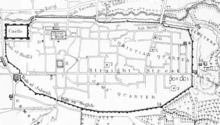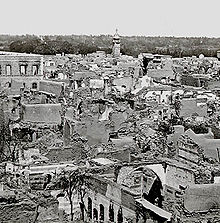Franciscan Monastery Damascus
The Franciscan Paulus Monastery ( Arabic دير الفرنسيسكان القديس بولس), also Latin monastery (دير اللاتين) or the Great Monastery (الدير الكبير), with the Franciscan Church (كنيسة الفرنسيسكان) or Latin Church (كنيسة اللاتينية) is a monastery of the Roman Catholic Order of Franciscans (OFM) in the Syrian capital Damascus and belongs to the Custody of the Holy Land . It is located in the Christian quarter of the old town near the city gate Bāb Tūmā .
General
The monastery is on the corner of Klosterstrasse (شارع الدير) with Bāb-Tūmā Street (شارع باب توما) coming from Bāb Sharqi Street (شارع باب شرقي), the eastern part of the historical Straight Street , to the north-eastern city gate Bāb Tūmā (Thomastorباب توما) leads. From the latter it is about 200 m south. Opposite the monastery on Klosterstrasse is the Maronite Antonius Cathedral .
The monastery and the church are the Paul of Tarsus ordained, the - first persecutor of the followers of Jesus - just outside the city of his Damascus experience had ( Acts 9.3 to 9 EU began) and in Damascus, as followers of the risen Jesus Christ to act ( Acts 9.20 EU ) before he fled the city - allegedly via Bab Kisan ( Acts 9.25 EU ). In the monastery church, near the side altar, there is the grave of the martyr Engelbert Kolland and seven Spanish Franciscans who died with him, as well as other relics. All eleven martyrs of 1860 - including the three deceased Maronite lay people - were on October 10, 1926 by Pope Pius XI. beatified and honored on July 10th.
The Franciscans look after the Roman Catholic Christians in Damascus, who belong to the Apostolic Vicariate in Syria . However, most of the visitors to the Franciscan Church are not Catholics. According to their own information, the Franciscans in Damascus take care of Christians of all denominations , since intensive pastoral work is not usual among the Orthodox . In 2020, Father Bahjat Elia Karakach will be the head of the Franciscan Monastery.
history

The Franciscans have been present with their monastery in Damascus for centuries, with brothers from Spain playing a leading role. According to the Handbook of Biblical Geography and Area Studies of 1844, the Monastery of the Franciscans of the Holy Land , in which eight priests from Spain lived, was one of three Roman Catholic monasteries in Damascus, next to the Monastery of the Lazarists (at the confluence of the Al-Azriya-Gasse / Lazarusgasse in Bab-Tuma-Strasse) and the monastery of the Capuchins , in which only one priest lived in 1832 . The disappearance of Father Tomaso and his Muslim servant Ibrahim Amara on February 5, 1840 from the Capuchin monastery, which no longer exists, led to the so-called Damascus affair , in which Jews in the city were accused of ritual murder and there were serious riots against Jews.
In the course of the civil war in the Lebanon Mountains , the Christian district of Damascus was sacked by Druze militias on July 9, 1860 , with many Christians initially taking refuge in the Paulus monastery. However, the militiamen managed to penetrate the monastery - allegedly through betrayal - and devastate it. Eleven Christian martyrs was paid to the death of from Tyrol originating Engelbert Kolland , seven Spanish friars - Manuel Ruiz (also called Emmanuel Ruiz), Juan Jacobo Fernandez, Carmelo Volta, Nicanor Ascanio, Pedro Soler, Nicolás María Alberca and Francisco Pinazo - and the three Maronite brothers Masabki - Fransis, 'Abd al-Muti and Rufayil - after refusing to forsake their faith in Jesus Christ.
The destroyed Capuchin monastery was not rebuilt after the Druze uprising. In 1866 the epitaphs of the Capuchin Father Thomas , who had been missing since the Damascus affair in 1840, and his Muslim servant Ibrahim Amara were transferred from there to the Franciscan Church, where they are still located today. At that time the epitaph of the Father was engraved in Italian and Arabic: "Here rest the bones of Father Thomas from Sardinia, an apostolic Capuchin missionary, murdered by Jews on February 5, 1840."
From 2013, during the civil war in Syria , the Bab Tuma district came under repeated attack by Islamist rebels. On January 8, 2018, Islamist mortar shells were fired again at the old city of Damascus from eastern Ghouta after a lengthy period of quiet, and the attacks continued in the weeks that followed. In addition to the Maronite cathedral , where up to five people are reported to have died on January 8, the Franciscan buildings were also badly hit. On February 21, 2018, three children died in a grenade attack on the Franciscan school. There was another targeted attack on Christian schools in Damascus on March 1, 2018. According to the Franciscan Father Bahjat Elia Karach, the 13 rockets hit exactly when the school was out. The aim of the rebels in Eastern Ghouta was to kill as many children as possible. The bombing ended with the capture of Eastern Ghouta by the Syrian army in April 2018.
Individual evidence
- ↑ a b Pilgrimage sites: Paulus monastery. Engelbert Kolland Community, Zell am Ziller. Retrieved May 6, 2020.
- ↑ Gerald H. Anderson: Biographical dictionary of Christian missions . Wm.B. Eerdmans Publishing Company, 1999. p. 582.
- ↑ a b The Massabki brothers. Living Maronite, accessed May 6, 2020.
- ↑ Peter's pupil: Syria - past and present . In: In the land of the Lord. Franciscan magazine for the Holy Land , vol. 73, 2/2019, pp. 54–75, here pp. 56f. and 69f. ( PDF )
- ↑ Fear of the consequences of the corona pandemic. Syrian Father in Great Concern - Donated oxygen generator is now in operation. Pfaffenhofener Kurier, April 22, 2020.
- ↑ Lorenz Clemens Gratz: Handbuch der Biblischen Erd- und Länderkunde , 1844. S. 59.
- ↑ Peter Haber : Between Jewish Tradition and Science. Dissertation . University of Basel 2005. Böhlau-Verlag, Cologne 2006, ISBN 3-412-32505-8 , p. 280.
- ↑ Allgemeine Zeitung des Judenthums. IV., No. 18, Leipzig, May 2, 1840, p. 253.
- ↑ Ronald Florence: Blood Libel. The Damascus Affair of 1840 . The University of Wisconsin Press, Madison (Wisconsin) 2004. Epilogue, p. 215.
- ↑ Kenneth R. Timmerman: Preachers of Hate: Islam and the War on America . Three Rivers Press (Random House), New York 2003. p. 71.
- ↑ Qui riposano le ossa del P. TOMMASO DA SARDEGNA Missionario Apostolico Cappuccino assassinato dagli ebrei il giorno 5 di febbraio del 1840 . Quoted in: Hellmut Schramm: Jewish Ritual Murder. A Historical Investigation . JRBooksOnline, 2017. p. 127.
- ↑ Matthew Davis: Damascus archbishop describes Syrian Catholics' plight. The Catholic Spirit, November 16, 2018.
- ↑ Giuseppe Caffulli (translation Paul Waldmüller OFM and Gabriel Gnägy OFM): In Damascus, monasteries and churches under bomb attack. Terra Santa, January 24, 2018.
- ↑ Damascus. Three children of the Franciscan school killed. Victims of the terrorist attacks from the “rebel-held Ghouta” on the Christian quarters of the Syrian capital. Ostkirchen.info portal, February 21, 2018.
- ^ Syria: Franciscans lament jihadist terror. Vatican News , March 5, 2018.
- ↑ Ulrich W. Sahm: “No alternative to Assad in Syria”. Israel Network, September 30, 2019.
Coordinates: 33 ° 30 ′ 42.9 ″ N , 36 ° 18 ′ 55.3 ″ E
